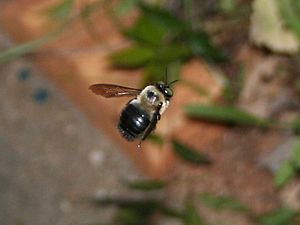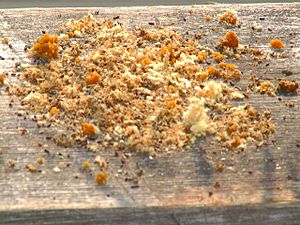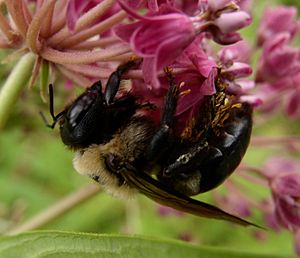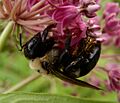Eastern carpenter bee facts for kids
Quick facts for kids Eastern Carpenter Bee |
|
|---|---|
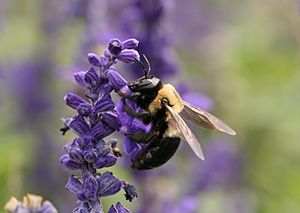 |
|
| Female Xylocopa virginica on Salvia | |
| Scientific classification | |
| Kingdom: | |
| Phylum: | |
| Class: | |
| Order: | |
| Family: |
Apidae
|
| Subfamily: |
Xylocopinae
|
| Genus: |
Xylocopa
|
| Subgenus: |
(Xylocopoides)
|
| Species: |
X. virginica
|
| Binomial name | |
| Xylocopa virginica Linnaeus, 1771
|
|
| Subspecies | |
|
|
The Xylocopa virginica, also known as the eastern carpenter bee, lives across the eastern United States and into Canada. These bees build their nests in different kinds of wood. They get their food, like pollen and nectar, from flowers. Unlike many other bee species, the eastern carpenter bee does not have a queen. Female carpenter bees are in charge of having babies, finding food, and building nests. Sometimes, their daughters help them.
Contents
What do Eastern Carpenter Bees Look Like?
Eastern carpenter bees are about the same size as bumblebees. However, they have a shiny, mostly black body with a slight purple color. Male and female carpenter bees weigh about the same. But you can tell them apart by looking at them. Males have a longer body and a white spot on their face. Females have a wider head.
These bees have special mouthparts called maxillae. They use these to make holes in flowers. This helps them reach the nectar inside. Their maxillae are sharp and wedge-shaped. This allows them to split the side of flower tubes. They can then get to the nectar easily.
Where Do They Live?
You can find X. virginica in many parts of North America. They live east of the Rocky Mountains. They are found as far north as Nebraska, southern Ontario, and Maine.
How Do They Build Nests?
Eastern carpenter bees build their nests in wood. They also use bamboo stems or agave stalks. But they like to nest in pine or cedar wood that has been cut. They build nests by scraping wood shavings from the walls. These shavings are used to make walls between different parts of the nest.
The entrance hole goes straight into the wood. But the tunnels inside run parallel to the wood grain. These nests can be social, with two to five females living together. Or they can be solitary, with just one bee. Social nests are more common.
Because they nest in wood, you often find them in furniture or buildings. These bees are very common in eastern North America. They live in small groups, so their nests are often seen.
Nests are usually round and have one to four tunnels. They have many branches. Each adult female lives and lays eggs in her own branch. But all females share one entrance. Building nests takes a lot of effort. So, females often reuse old nests.
Life Cycle of the Eastern Carpenter Bee
Eastern carpenter bees mate once a year in the spring. Eggs are laid in July. The eggs farthest from the exit hole are laid first. By August and mid-September, the young bees have grown into adults.
New adult bees have soft bodies and white wings. Their wings later turn brown, then bluish-black. They can fly a few days after they emerge. But they stay in their nest for at least two weeks. During this time, they drink nectar but do not eat pollen. The young bees start their own mating cycle the next spring. This means one generation grows each year.
Older female bees start to show signs of aging around July. They might rest in flowers or stay in the nest. They may even fall to the ground while flying. Older bees also crawl and avoid flying. They do not struggle if a human handles them. These old bees die by early August. This is when the new young bees come out of their cells. There is not much time when both old and new bees are alive. However, some females do live through a second winter.
How Do They Behave?
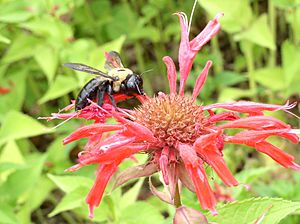
Eastern carpenter bees are not completely solitary, but they are not truly social either. They show a weak form of social behavior. One female does most of the work and cares for her sisters. This might be a step in how social behavior evolved in bees.
Who's in Charge?
Female carpenter bees can have nests alone. But they usually live in groups. The social groups have three types of females: primary, secondary, and tertiary.
- Primary females are the leaders in a nest. They are in charge of having babies. They also find food for the young bees and lay all the eggs.
- Secondary females might sometimes lay eggs. They also help by finding food for the young or keeping the nest clean.
- Tertiary females rely on the primary females for food and shelter. They stay inactive and wait for winter to pass.
Studies show that primary females have usually lived through two winters. Tertiary bees have only lived through one winter. Tertiary bees are likely to survive a second winter and become primary females next year.
Who Does What Work?
Not all females in a social nest do the same work. Older females are responsible for nesting duties. This includes digging, making cells, lining cells, collecting food, and laying eggs. You can tell they do this work because their mouthparts show wear.
Younger females rarely leave the nest. They guard the entrance while the older females work. This means their wings and mouthparts are not worn. X. virginica is the only known bee species where one-year-old females live with two-year-old females who do all the work.
Male bees often spend a lot of time flying around. They also chase away intruders. Female bees fly directly to flowers and food spots. Larger females have an advantage. They can carry more pollen or nectar back to the nest. They can also fly longer distances.
What Do They Eat?
Eastern carpenter bees mainly eat nectar and pollen. New bees do not have food stored in their nest. But sometimes, older bees bring them nectar.
X. virginica uses its mouthparts to poke holes in flowers. This helps them get to the nectar inside. This is called "nectar robbing." They pierce the flower tubes to get nectar. This way, they do not touch the parts of the flower that help with pollination. For some plants, this means fewer fruits and seeds. But other plants have ways to still be pollinated even if the flower is pierced.
Mating Behavior
Each nest usually has one mated bee. Mating happens in April. It often involves a special dance with about a dozen males and a few females.
Males need females to be flying to mate. Sometimes, before mating, the male and female will face each other and hover for a few minutes. When the male touches the female, he gets on her back. He tries to push his body under hers. Then they mate. This is almost always followed by more mating attempts.
If the female lands during mating, the bees will separate. The male will hover and wait for the female to fly again. Sometimes, males will hold onto the female with all six legs. They will flap their wings to try and lift her back into the air.
Larger males are usually better at mating. Because they are bigger, males will often claim an area near female nests. Smaller males will stay at places where they find food. Or they will go to other areas where they think females might pass by. This way, they can mate with less competition.
Defense and Safety
Male Territories
Male carpenter bees set up territories near active nest entrances. They do this to protect the colony and find chances to mate. For males near the nest entrance, their territory is usually a long, narrow area. For males farther away, their territory is usually a square shape and shorter.
Males can stay in one territory for up to two weeks. They mostly find food and rest at night. But they also take short breaks during the day. After these breaks, they often have to fight off other bees that have entered their territory.
Males will not react to another bee unless it is flying very fast. If another bee hovers near the nest, the male probably won't chase it. But if another male enters the territory at high speed, the male will chase it.
Parasites
One type of fly, called Xenox tigrinus, is known to be a parasite of eastern carpenter bee larvae. This means the fly uses the bee larvae for its own survival.
Stinging
Male carpenter bees cannot sting. Their stinger is a modified part that males do not have. However, they will often fly close to humans and buzz loudly. This can seem scary, but they cannot hurt you.
Female carpenter bees can sting. The pain level of their stings is not well known. But researchers say that X. virginica will sting if they are handled roughly. Their stinger is not barbed, so a female can sting many times.
Why Are They Important to Humans?
Helping Plants Grow
Eastern carpenter bees visit many different kinds of flowers. They gather pollen and nectar to bring back to their nests for their young. Most of the plants they visit are wild or grown for decoration. However, they are good pollinators for blueberry crops.
They are active for a long time each year. They also get food from many different plant species. The start of their active season depends on the temperature. This makes it easy for greenhouse workers to control when they start looking for food. But compared to bees like the honey bee, their smaller nests make them less powerful as pollinators.
Damage to Wood
Because X. virginica builds nests in wood, they can weaken man-made structures. They also make droppings when they leave their tunnels. These can splash on buildings and make them look bad.
However, the good things these bees do as pollinators are much more important than the damage they cause. X. virginica help pollinate fruits, vegetables, and flower crops. While they are not as strong at pollinating as bumblebees or honey bees, their help is still very valuable.
One way to keep them out of unwanted areas is to stain entrances white. Carpenter bees tend to avoid white-stained entrances.
Images for kids



